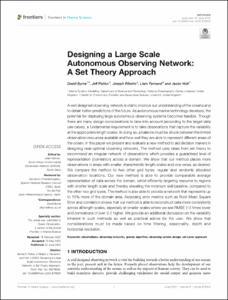Designing a Large Scale Autonomous Observing Network: A Set Theory Approach.

View/
Average rating
votes
Date
2022Author
Byrne, David
Polton, Jeff
Ribeiro, Joseph
Fernand, Liam
Holt, Jason
Metadata
Show full item recordAbstract
A well designed observing network is vital to improve our understanding of the oceans and
to obtain better predictions of the future. As autonomous marine technology develops, the
potential for deploying large autonomous observing systems becomes feasible. Though
there are many design considerations to take into account (according to the target data
use cases), a fundamental requirement is to take observations that capture the variability
at the appropriate length scales. In doing so, a balance must be struck between the limited
observation resources available and how well they are able to represent different areas of
the ocean. In this paper we present and evaluate a new method to aid decision makers in
designing near-optimal observing networks. The method uses ideas from set theory to
recommend an irregular network of observations which provides a guaranteed level of
representation (correlation) across a domain. We show that our method places more
observations in areas wit.....
Journal
Frontiers in Marine ScienceVolume
9Issue
Article 879003Page Range
15pp.Document Language
enSustainable Development Goals (SDG)
14.aMaturity Level
ConceptDOI Original
https://doi.org/10.3389/fmars.2022.879003Citation
Byrne, D., Polton, J. Ribeiro, J., Fernand, L. and Holt, J ,(2022) Designing a Large Scale Autonomous Observing Network: A Set Theory Approach. Front.iers in Marine Science, 9:879003, 15pp. DOI: 10.3389/fmars.2022.879003Collections
The following license files are associated with this item:
 Repository of community practices in Ocean Research, Applications and Data/Information Management
Repository of community practices in Ocean Research, Applications and Data/Information Management
